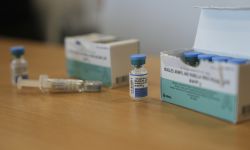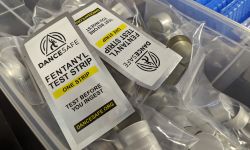West Michigan contact tracers are overwhelmed by volume of COVID cases

In Kent County, dozens of health investigators and contact tracers are in a daily race to reach confirmed cases of COVID-19 and stop its spread.
But it’s a race health officials concede they’re now losing. Health officials say they could use twice as many contact tracers as they now have on staff as Kent logs hundreds of cases a day ─ just one of many West Michigan counties where coronavirus cases are surging to record highs.
“Our capacity to contact trace is about 130 cases a day. When we get more than that, it’s challenging to keep up,” Brian Hartl, who directs community health strategy for the Kent County Health Department, told Bridge Michigan.
Coronavirus cases in the county have averaged 251 a day over the past week. That’s more than 50 percent higher than a week earlier, when its seven-day average was 165.
Before the recent spike in cases, Hartl estimated that COVID-19 case investigators were reaching about two-thirds of individuals with confirmed positive test results, usually by phone, within a day.
But Hartl said that’s plunged to about 10 percent, as the case surge overwhelms the county’s ability to track (and hopefully, curtail) its spread.
As of Wednesday, Kent County averaged 38 COVID-19 cases per 100,000 people ─ well above the state average of 24 cases per 100,000. And Kent has plenty of company, with counties in much of the state hitting record levels as well. Michigan is recording about 2,500 new cases a day – the highest average since the beginning of the pandemic.
- Michigan coronavirus unemployment, map, curve, COVID-19 updates
- Dashboard: Michigan coronavirus testing numbers, trends, COVID-19 data
Neighboring Ottawa County is similarly overwhelmed. Its cases shot up by more than 70 percent in a week, from an average of 60 a week to 103 on Wednesday.
Health officials there say they’re also straining to keep pace with a coronavirus wave that’s the highest it’s been all year, except for a one-day spike in September linked to an outbreak at Grand Valley State University.
“We are continually seeing an increase in cases. It’s certainly making it difficult to do contract tracing,” said Kristina Wieghmink, spokesperson for the Ottawa County Department of Public Health.
But even as cases rise, Wieghmink said the lack of workers is just one barrier to getting COVID under control. Uncooperative carriers of the virus complicate efforts.
Some individuals who test positive for the coronavirus don’t pick up the phone when reached by a tracer. Or they hang up. Still others won’t identify people who they’ve been in close contact with.
Wieghmink said the current polarized political environment ─ in which defiance of public health recommendations like wearing a mask can be a badge of honor ─ only adds to the potential for further COVID-19 spread.
“There’s so much public discourse and trust issues in government. People don’t like being told what to do.
“But we can only be successful if we partner with those in the community to box in this virus. These are the best tools we have, since we don’t have a vaccine or treatment.”
Contact tracing is aimed at reaching newly infected people as quickly as possible so they can isolate and quarantine themselves — and, just as important, warn others who may have been physically close to them to do the same — to break the chain of community spread. Guidelines from the U.S. Centers for Disease Control and Prevention advise those who were within six feet of an infected individual for more than 15 minutes to quarantine for 14 days.
But that system works well only if health investigators connect with infected individuals within a day or two of their confirmed positive test, persuade them to isolate, and then quickly track down their close contacts and convince them to isolate as well.
There are widespread reports of breakdowns in that system across the country.
In South Florida, the mayor of Miami Beach issued a letter in late July that said contact tracers were reaching less than a fifth of infected individuals, which he blamed on understaffing and lack of coordination between state and local health officials. .
In New York City, just 42 percent of coronavirus patients reached by a tracer provided the name of even a single person they may have infected. That’s a cooperation rate that experts consider too low to effectively minimize spread.
In late July, CDC Director Robert Redfield testified that there were about 28,000 people in the United States doing contact tracing work. That was far below the minimum 99,000 tracers that the Association of State and Territorial Health Officials estimated were needed.
Other public health advocates put the need at 300,000 tracers.
Effectively sleuthing the virus also requires quick turnaround of testing results ─ ideally, within a day or two, which is not always happening. A study in the medical journal Lancet Public Health concluded that COVID-19 testing results that take five days or longer to get back are all but useless in halting further spread of the virus.
Earlier this year, officials at Michigan’s Department of Health and Human Services reported that test results were taking up to a week to complete. Asked how long it now takes for completion of those tests, MDHHS spokesman Bob Wheaton told Bridge Thursday the state does not know.
“That information isn’t provided to us by the labs/test sites,” Wheaton wrote in an email.
But with the statewide spike in cases, state health officials confirm it’s taking their team of disease investigators longer to reach infected individuals.
According to MDHHS data, investigators reached about 60 percent of confirmed COVID-19 cases within a day of their positive test result in a 30-day period from Aug. 28 through Sept. 26. But that fell to 50 percent in the following 30-day period that ended Oct. 26.
Over the past month, state health investigators failed to reach more than a third of those infected with coronavirus within two days. And for the 30-day period that ended Oct. 20, investigators had failed to reach a fifth of positive cases after seven days.
Jonathan Warsh, chief of staff for MDHHS Director Robert Gordon, said contact tracing remains a health strategy that rises or falls based on the assistance it gets from the public.
“The bigger problem in contact tracing is in individuals not picking up the phone or picking up the phone and not complying with the quarantine,” Warsh told Bridge.
“It’s essential. It’s the only way we have to identify people who are positive and isolate them and quarantine their contacts. We really have no other ways to slow the spread of the disease other than more draconian measures that nobody wants to see.”
Despite the spike in COVID-19, Warsh said the state is “still at a point” where contact tracing works. But he said that could reach a breaking point if cases continue to rise.
“We could get there this winter if we don’t take this seriously,” he said.
Hartl, the Kent County official, said the county’s tracing efforts rely on a combination of health department case investigators ─ who reach out to infected individuals ─ and contact tracers hired by a private firm and paid about $20 an hour to connect with individuals named as close contacts.
Between the two, he said they add up to 56 full-time positions.
“Right now, I have about 30 people [dedicated to contact tracing] a day. I could probably use 60.”
Hartl might have gotten some extra help if a group of U.S. Senate Republicans succeeded in their push for $25 billion in added federal funding to help states beef up testing and contact tracing. That was less than the $75 billion Democrats were seeking.
But the Trump administration in July balked at even the smaller GOP proposal and any added funding for contract tracing appears to be in limbo in the run-up to the Nov. 3 elections.
Kent County’s health department recently rolled out a digital tool to contact infected people. It sends a text message or email with a link to a confidential questionnaire that asks information on their symptoms, close contacts and exposure to the disease.
“Hopefully, with the use of this technology, it’s going to reduce the burden on our staff, increase the number of cases that they can actually get through on a daily basis to keep up with the demand,” Hartl said.
Over the past four months, a suburban Grand Rapids resident named Deborah has put in about 20 hours a week as a contracted contact tracer with the county. She asked that her last name not be used because of the sensitive nature of her work.
By and large, she said, most people with confirmed infections cooperate with the disease survey and name those who have been in close contact.
But some flat out refuse.
“I try never to make it adversarial. I try to reassure them that this is to help people, try to appeal to that.
“But at the end of the day, I have to respect their position. I understand that a lot of people are concerned about their privacy. We don’t want to come across as the COVID police. It’s an uphill battle, the whole thing.”
In Calhoun County, southeast of Kent, COVID-19 cases are soaring to some of the highest rates in the state, reaching 54 cases per 100,000 on Wednesday, a jump of 38 percent from a week earlier.
Kevin Green, environmental public health director for the Calhoun County Public Health Department, said that as cases rise, the county has turned to MDHHS investigators to help reach infected individuals more quickly.
“Right now, we’re doing the best we can,” he told Bridge. “But we’re getting close to the tipping point of how effective this can be.”
Green estimated officials there are reaching up to 75 percent of people with confirmed cases within a couple days.
For those they don’t reach by phone, the county sends a health worker to their home address to hang a contact message on their door knob. If that doesn’t prompt a reply, it sends out a letter ─ which in some cases may also go unanswered.
In recent weeks, Green said it’s proving harder to identify and find those who were in close contact with infected individuals.
“We’re finding more people that won’t give us other names. I don’t know why,” he said, declining to speculate on whether the tense political climate over COVID-19 is feeding that defiance.
Contact tracing is not perfect, Green conceded. But the alternative is worse.
“Without it,” he said, “the numbers would be even higher.”
See what new members are saying about why they donated to Bridge Michigan:
- “In order for this information to be accurate and unbiased it must be underwritten by its readers, not by special interests.” - Larry S.
- “Not many other media sources report on the topics Bridge does.” - Susan B.
- “Your journalism is outstanding and rare these days.” - Mark S.
If you want to ensure the future of nonpartisan, nonprofit Michigan journalism, please become a member today. You, too, will be asked why you donated and maybe we'll feature your quote next time!








